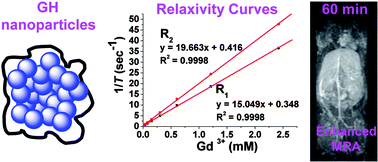Bioinspired synthesis of gadolinium-based hybrid nanoparticles as MRI blood pool contrast agents with high relaxivity†
Abstract
A unique biomineralization approach was developed to synthesize gadolinium-based hybrid (GH)

Maintenance work is planned for Wednesday 1st May 2024 from 9:00am to 11:00am (BST).
During this time, the performance of our website may be affected - searches may run slowly and some pages may be temporarily unavailable. If this happens, please try refreshing your web browser or try waiting two to three minutes before trying again.
We apologise for any inconvenience this might cause and thank you for your patience.
* Corresponding authors
a
The Institute for Advanced Materials & Nano Biomedicine, Tongji University School of Medicine, Shanghai 200092, China
E-mail:
bingbozhang@tongji.edu.cn
Fax: +86-21-65983706-0
Tel: +86-21-65983706-819
b Department of Radiology, ChangZheng Hospital, the Second Military Medical University, No. 415 Fengyang Road, Shanghai 200003, China
c Shanghai First Maternity and Infant Hospital, Tongji University, Shanghai 200040, China
d
School of Electronic and Computing Systems, University of Cincinnati, Cincinnati, OH 45221-0012, USA
E-mail:
donglu.shi@uc.edu
A unique biomineralization approach was developed to synthesize gadolinium-based hybrid (GH)

 Please wait while we load your content...
Something went wrong. Try again?
Please wait while we load your content...
Something went wrong. Try again?
B. Zhang, H. Jin, Y. Li, B. Chen, S. Liu and D. Shi, J. Mater. Chem., 2012, 22, 14494 DOI: 10.1039/C2JM30629H
To request permission to reproduce material from this article, please go to the Copyright Clearance Center request page.
If you are an author contributing to an RSC publication, you do not need to request permission provided correct acknowledgement is given.
If you are the author of this article, you do not need to request permission to reproduce figures and diagrams provided correct acknowledgement is given. If you want to reproduce the whole article in a third-party publication (excluding your thesis/dissertation for which permission is not required) please go to the Copyright Clearance Center request page.
Read more about how to correctly acknowledge RSC content.
 Fetching data from CrossRef.
Fetching data from CrossRef.
This may take some time to load.
Loading related content
